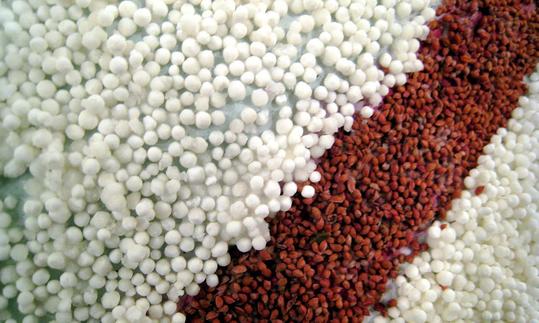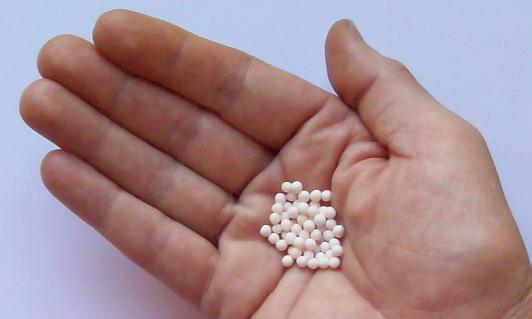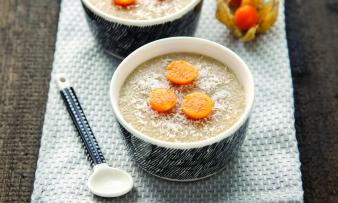Table of contents
Tapioca balls, also called tapioca pearls or pearl tapioca, are made from tapioca starch, which is obtained from cassava roots ( Manihot esculenta). While tapioca starch in powder form, preferably organic quality, is used for baking or as a binding agent for soups and sauces, tapioca balls are primarily used for preparing desserts. Due to the way they are produced, they are not raw.
Use in the kitchen
What is tapioca? Tapioca is a relatively tasteless, purely plant-based food starch. What is tapioca made of? What are tapioca pearls made of? The vegan starch is a by-product of the production of cassava flour, which is obtained from cassava. The starch from cassava roots can be found in the form of powder as tapioca flour, as tapioca flakes and in the form of beads of various sizes as pearl tapioca. In this article, we focus primarily on tapioca beads. How do you prepare tapioca pearls? These are hard and firm when dry, which is why you soak them before using them. When cooked, the tapioca beads, which are white in their unprocessed state, swell and change color to transparent. However, the color and taste of the pearls can be adjusted using sweeteners, fruit syrup, sauces and food coloring.
Tapioca balls are a popular ingredient not only in South America, where the cassava root comes from, but also in Africa and Asia. In East Asian and Southeast Asian cuisine, they are used in sweet dishes, desserts and sweet drinks. A new trend from Asia that has also reached the USA and Europe is "bubble tea", which mainly consists of tea, milk, syrup and large tapioca balls (also called boba) sweetened with brown sugar and thus colored black.
Tapioca pearls - especially smaller pearls - are ideal as a binding agent for sweet soups, puddings and desserts. Tapioca puddings, which can be enjoyed not only as a dessert but also for breakfast, can be prepared with all kinds of spices, nuts, fruits (e.g. mango, pineapple,raspberries, strawberries, kiwis) and even chocolate. You can find a basic recipe for tapioca pudding by clicking here. Immediately after this you will find another vegan tapioca pearl recipe.
Your own preparation
How do you make tapioca pearls? With a little patience, you can also make tapioca pearls yourself. To do this, mix tapioca starch with hot water to form a smooth dough. To make colorful tapioca pearls, add a little food coloring or brown sugar or maple syrup, which will color the dough brown. Then form the pearls into the desired size, put them in boiling water and simmer for about 10-15 minutes. It's best to use them up straight away.
Vegan recipe for tapioca pudding with cinnamon cherries
Ingredients (for 4 people): 100 g small tapioca pearls, 800 ml coconutmilk, 1 tsp vanilla powder, 1 tsp cinnamon powder, ½ tsp cardamom powder, 1 pinch sea salt, 3-4 tbsp agave syrup, 600 g sour cherries (frozen), 2 tbsp agave syrup, 1 pinch cinnamon, 1 tsp locust bean gum.
Preparation: Take the sour cherries out of the fridge and let them thaw. Soak the tapioca pearls in cold water for about an hour. Pour off the water and bring the tapioca pearls to the boil in a pan with coconut milk, vanilla, 1 teaspoon of cinnamon, cardamom and sea salt. Simmer for 10 minutes, stirring occasionally. Remove the pan from the heat and stir in 3-4 tablespoons of agave syrup. Let the pudding swell for about 30-45 minutes with the lid closed, stirring occasionally. In another pan, heat the thawed sour cherries with 2 tablespoons of agave syrup and a pinch of cinnamon. Stir in the carob bean gum. Bring to the boil briefly. Fill four glasses with a layer of sour cherries followed by a layer of tapioca pudding. Finally, add a small dollop of sour cherries on top and serve the vegan tapioca dessert.
Vegan recipes with tapioca balls can be found under the note: " Recipes that have the most of this ingredient ".
| Not only vegans or vegetarians should read this: Vegans often eat unhealthily. Avoidable nutritional errors. |
Purchasing - Storage
Tapioca beads are generally not found in most supermarkets (e.g. Coop, Migros, Denner, Volg, Spar, Aldi, Lidl, Rewe, Hofer, Billa) and organic supermarkets (e.g. Alnatura, Denn's Biomarkt). Only well-stocked branches of Edeka offer pearl tapioca. You'll have more luck in health food stores, drugstores, Asian shops and online shops.
Storage tips
Dry pearls and tapioca starch in general should be stored in a dry, airtight container to protect them from contact with moisture. If you have cooked pearls left over, you should put them in a sugar syrup, store them in the fridge and use them within two days. The consistency may change slightly during storage.
Ingredients - Nutritional values - Calories
Tapioca balls (dry) have 358 kcal per 100 g. These come mainly from carbohydrates (89 g/100g). Fat (0.02 g/100g) is hardly present. Proteins (0.19 g/100g) and fiber (0.9 g/100g) are also only present in small amounts - the situation is similar with corn starch. 1
Pearl tapioca contains only small amounts of vitamins and minerals. It contains 1.6 mg of iron per 100 g, which is 11% of the daily requirement. A similar amount is found in durum wheat semolina (1.2 g/100g) and light spelt flour (1.2 mg/100g), significantly less in corn starch (0.47 mg/100g) and significantly more in wholemeal spelt flour (9.7 mg/100g). 1
100 g of tapioca pearls also contain 0.11 mg of manganese (6% of the daily requirement). Corn starch contains slightly less manganese (0.05 mg/100g). Whole wheat flour contains 4.1 mg/100g, which is more than 37 times as much. 1
The calcium content is also relatively modest at 20 mg per 100g (3% of the daily requirement). This can be compared with that of soft wheat semolina (17 mg/100g) and yam (17 mg/100g). Chia contains a particularly high amount of calcium (631 mg/100g). 1
Although cassava is rich in secondary plant substances, 11 the starch obtained from it (tapioca starch) is not known to contain any significant amounts.
The complete ingredients of tapioca balls, the coverage of the daily requirement and comparison values with other ingredients can be found in our nutrient tables. In the article Nutrients explained you will get a detailed insight into the topic.
Health effects
Is tapioca gluten-free? Pearl tapioca consists of gluten-free tapioca starch and is therefore suitable for people with gluten intolerance (celiac disease).
Is tapioca healthy? Starch plays a central role in providing the metabolic energy that enables the body to function. Starch can be divided into three categories: rapidly digestible starch, slowly digestible starch and resistant starch. The term resistant starch refers to the sum of starch and starch degradation products not absorbed in the human small intestine. Resistant starch, which microorganisms ferment in the large intestine, has positive effects on human health and intestinal health, and can help with diabetes, some types of cancer, cardiovascular disease, obesity and osteoporosis. Tapioca contains only a modest amount of resistant starch (between approximately 0.56-1.1%), but according to a study that examined cassava products, this is enough to make it a useful product for the gastrointestinal tract. 2
Because of its high calorie and carbohydrate content, people who need to gain weight quickly can include tapioca in their diet. However, care should be taken not to consume too much sugar and other sweeteners along with the pellets.
Dangers - Intolerances - Side effects
Although tapioca is low in fat, it is also low in vitamins and minerals. Due to the limited nutritional value of tapioca starch, it is not a healthy basis for a daily diet. Nevertheless, in many places in South America and Africa, many people eat cassava and tapioca-based meals two to three times a day. Nutrient deficiencies and resulting diseases are the result of this. To counteract this problem, scientists experimented with enriching tapioca with more nutrient-rich flours such as soy flour. 3
The cassava root, from which tapioca starch is obtained, contains cyanogenic glycosides (e.g. linamarin), which release poisonous hydrogen cyanide. If the production steps are carried out properly, commercially produced tapioca pearls should be free of these. You can find out more about cyanogenic glycosides under the ingredient cassava.
The sugar content of the trendy drink "bubble tea" (tea with starch beads) is high due to the pre-sweetened tapioca pearls and fruit syrup. Regular consumption could have negative effects on health and, for example, promote obesity, especially in children, and the resulting diseases such as diabetes, cardiovascular disease and certain types of cancer. 4 A study at Diponegoro University in Indonesia also showed the connection between the consumption of "bubble tea" and the occurrence of acne (acne vulgaris). According to this and earlier studies, the ingredients contained in "bubble tea" - sugar, milk and tapioca - are responsible for promoting acne. 5
Ecological footprint - animal welfare
The ecological footprint of a food depends on various factors. The type of agricultural production (conventional vs. organic), seasonal, regional or domestic production or import by truck, ship or plane, different types of packaging and whether the goods are fresh or frozen all play a decisive role. 12
The CO 2 footprint for the production of tapioca starch varies depending on the manufacturer. For 1 kg of tapioca starch, the CO 2 footprint is estimated at 0.86 kg CO 2 eq/kg. 13
The water footprint for producing 1 kg of tapioca starch is 2254 litres of water. 14 The production of tapioca requires large amounts of water and energy. In addition, organically contaminated wastewater and solid waste are produced. In 2005, the Thai Ministry of Industrial Works launched a programme to develop measures to prevent environmental pollution in tapioca starch factories. A study as part of the programme investigated clean technologies to reduce water consumption and wastewater volumes. The proposed measures include recycling water in the various production steps. 7
Worldwide occurrence - cultivation
Tapioca pearls are now sold worldwide. Analyses assume a sharp increase in market share in the Asia-Pacific region. The main players in these countries are focusing on, among other things, the introduction of new drinks with innovative flavors in order to attract more consumers. In North America (USA and Canada) too, it is assumed that bubble teas will become increasingly popular and, associated with this, the production of tapioca pearls will increase worldwide. 15
According to current knowledge, the cassava plant, which is the basis for tapioca, comes from the western Amazon region. 6 More information on the origin and history of the plant can be found under the ingredient: cassava, raw (organic?).
Industrial production
Tapioca starch is a by-product of cassava flour production. Production includes: washing the cassava root, crushing and grinding, separating fibrous residues, dewatering and protein separation, dehydration and drying. 7
The commercial production of tapioca balls is divided into three steps: preparing moist cassava flour (1), gelatinizing (2) and drying (3). Starch balls of the desired diameter are prepared from moist and crushed cassava flour lumps using mechanical processes or the Gangsor method common in Indonesia. This is followed by gelatinization at high to moderate temperatures. This changes the molecular arrangement of the starch and the pearls do not disintegrate. This also creates the typical consistency - with water, the starch forms viscous solutions and after cooling, gelatinous masses. This is followed by a drying step to reduce the moisture content of the balls to around 12%. 8
Further information
Cassava ( Manihot esculenta) belongs to the spurge family (Euphorbiaceae). It is also called cassava or yuca. The word "tapioca" is derived from "tipioca", the name used by the Tupi Indians for the food that settles out of the liquid of the grated cassava roots and is processed into pellets (tipiocet). 9
Alternative names
Tapioca balls are also known as tapioca balls, tapioca pearls, tapioca pearls and pearl tapioca. Many misspellings (e.g. tapiok, topiak, tapoika, taipioka, tapjoka, tapuoka, tabijoka, tapijoka, tqpioka, tspioka, tabioka, topioka, tabjoka, kapioka, tapioca balls, tapioca pearls, tapioca pearls, manioc pearls, tapioca starch) creep in.
Sometimes the term 'sago' also crops up. Originally, the starch pellets extracted from the pith of the sago palm tree's trunk were called sago. Nowadays, the tapioca pellets are also sometimes called sago.
In English the beads are called tapioca pearls, tapioca balls or boba.
Other uses
Tapioca is also used outside the kitchen. Tapioca starch is used as animal feed (feed pellets), glue and for the production of paper, toothpaste and textiles. 7,10
Bibliography - 15 Sources (Link to the evidence)
| 1. | USDA United States Department of Agriculture. |
| 2. | Pereira BLB, Leonel M. Resistant starch in cassava products. Food Science and Technology. 2014;34:298–302. |
| 3. | Kolapo AL, Sanni MO. A comparative evaluation of the macronutrient and micronutrient profiles of soybean-fortified gari and tapioca. Food and Nutrition Bulletin. 2009;30(1):90–94. |
| 4. | Min JE, Green DB, Kim L. Calories and sugars in boba milk tea: implications for obesity risk in Asian Pacific Islanders. Food Sci Nutr. 2016;5(1):38–45. |
| 5. | Subagio D. Budiastuti A. Aryoko Widodo YL. Riyanto P. Association between Bubble Tea Consumption and Prevalence of Acne Vulgaris. CDK. 2021;48(7):383–386. |
| 6. | Cook JH, Connor DJ. Cassava. In Sadras VO, Calderini DF, Hrsg. Crop Physiology Case Histories for Major Crops. London: Elsevier; 2021: 588–633. |
| 7. | Chavalparit O. Ongwandee M. Clean technology for the tapioca starch industry in Thailand. Journal of Cleaner Production. 2009;17(2):105–110. |
| 8. | Fao org: Cassava processing. Cassava flour and starch. Baked tapioca products. |
| 9. | Fao org: Cassava processing. Introduction. |
| 10. | Fao org: Utilization of cassava products. Cassava starch and its uses. |
| 11. | Scaria SS, Balasubramanian B, Meyyazhagan A, Gangwar J, Jaison JP, Kurian JT, Karthika P, Manikanatan P, Sungkwon P, Kadanthottu SJ. Cassava (Manihot esculenta Crantz)—A potential source of phytochemicals, food, and nutrition—An updated review. eFood. 2024;5(1):e127. |
| 12. | Reinhardt G, Gärtner S, Wagner T. Ökologische Fussabdrücke von Lebensmitteln und Gerichten in Deutschland. IFEU Institut für Energie- und Umweltforschung Heidelberg. 2020:1–22. |
| 13. | Carboncloud com: Tapioca starch. |
| 14. | Mekonnen MM, Hoekstra AY. The green, blue and grey water footprint of crops and derived crop products. Hydrol. Earth Syst. Sci. 2011;15:1577–1600. |
| 15. | Future Market Insights com: Tapioca Pearls Market Snapshot (2022-2032). |











Comments